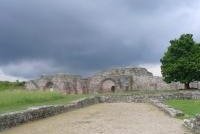
Gamzigrad Romuliana is a bit off the beaten track Wh site (as all of Serbia is), but really worth to see. It is not a great adventure to go there – but requires some time. Can be done as a day trip from Belgrade – providing you have your own vehicle, and you get up quite early. Most visitors will approach Gamzigrad from the Belgrade – Nis motorway –as we did it. There is a huge brown signboard before the exit, so you cannot miss it.
From trhe motorway it is less than 100 km, but be prepared, road conditions are quite various. After a couple of km of really good road we had to make a detour on curvy and humpy-bumpy country roads. In a sunny summer day it could have benne fun – driving through the Serbian villages. At night, in a thunderstorm it was a nightmare. A road seemed to be endless, but after almost two hours we reached Zajecar. This sleepy provincial town (the name means something like Rabbitville in Serbian), proved to be very friendly and surprisingly good looking. We found a cheap hotel (USD 30 for a double) and prepared ourselves for the next day in Ganzuigrad.
To reach Gamzigrad from Zajecar is easy, the road is well signposted, and in the sunshine the whole area looked much friendlier than last night. We first could see the site from the narrow tar road leading to the entrance through the fields. It is a fantastic sight. With its massive towers and walls the palace of Galerius still rules the area after 1500 years. For a historian it is even more important – as the almost only remain of the late Roman military architecture in this region. At least none of them is so huge. Early explorers believed the ancient ruins to have been a Roman military camp, because of their size and numerous towers.
Coming closer, in the parking lot we had to realize, that it is bigger then we thought – the walls are at lest four meters high on their highest point. We were offered a golf car from the parking lot to the entrance – the price is included in the entrance fee.
Inside there is a small museum, where a knowledgeable guide – presumably an archeologist – explained us the story of the building in bright English.
Ha told us that, systematic archaeological excavations conducted since 1953 revealed that the site was, in fact, an Imperial palace. It was conceived and built by one of the Tetrarchs, Emperor Galerius, the adopted son and son-in-law of the great Emperor Diocletian. Galerius started construction in 298 (after a victory over the Persians that brought him admiration and glory) to mark the place of his birth. The name Felix Romuliana was given in memory of his mother Romula, who was also a priestess of a pagan cult. The complex of temples and palaces served three main purposes - a place of worship of his mother’s divine personality, a monument to his deeds as emperor, and a luxurious villa for Galerius. Romuliana survived until it was plundered by the Huns in the mid 5th century. Later the site became a humble settlement of farmers and craftsmen, finally to be abandoned at the beginning of the 7th century with the arrival of the Slavs.
After the explanation we were allowed to explore the site ourselves. (We were the only tourists that time. ) The inner structures are mostly in ruins, much less impressive than the walls and the towers. Though the remains of the grand temple and the palace are really nice. (And it is a great experience to wander around a Roman city alone – something that you can never do in Italy or France.)
But even though it is a pity that so few tourists dare to put this site (and Serbia)on their travel plan.
More on
Comments
No comments yet.
